
The skull, or cranium, is typically a bony enclosure around the brain of a vertebrate. In some fish, and amphibians, the skull is of cartilage. The skull is at the head end of the vertebrate.

In anatomy, the temporomandibular joints (TMJ) are the two joints connecting the jawbone to the skull. It is a bilateral synovial articulation between the temporal bone of the skull above and the condylar process of mandible below; it is from these bones that its name is derived. The joints are unique in their bilateral function, being connected via the mandible.
The quadratojugal is a skull bone present in many vertebrates, including some living reptiles and amphibians.

The articular bone is part of the lower jaw of most vertebrates, including most jawed fish, amphibians, birds and various kinds of reptiles, as well as ancestral mammals.

A snake skeleton consists primarily of the skull, vertebrae, and ribs, with only vestigial remnants of the limbs.

In anatomy, the masseter is one of the muscles of mastication. Found only in mammals, it is particularly powerful in herbivores to facilitate chewing of plant matter. The most obvious muscle of mastication is the masseter muscle, since it is the most superficial and one of the strongest.
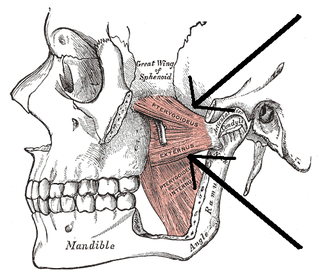
The lateral pterygoid muscle (or external pterygoid muscle) is a muscle of mastication. It has two heads. It lies superior to the medial pterygoid muscle. It is supplied by pterygoid branches of the maxillary artery, and the lateral pterygoid nerve (from the mandibular nerve, CN V3). It depresses and protrudes the mandible. When each muscle works independently, they can move the mandible side to side.

The pharyngeal arches, also known as visceral arches, are transient structures seen in the embryonic development of humans and other vertebrates, that are recognisable precursors for many structures. In fish, the arches support the gills and are known as the branchial arches, or gill arches.

The condyloid process or condylar process is the process on the human and other mammalian species' mandibles that ends in a condyle, the mandibular condyle. It is thicker than the coronoid process of the mandible and consists of two portions: the condyle and the constricted portion which supports it, the neck.
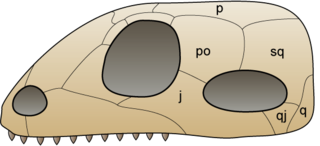
The squamosal is a skull bone found in most reptiles, amphibians, and birds. In fishes, it is also called the pterotic bone.
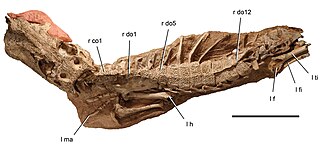
Anatosuchus is an extinct genus of notosuchian crocodyliforms discovered in Gadoufaoua, Niger, and described by a team of palaeontologists led by the American Paul Sereno in 2003, in the Journal of Vertebrate Paleontology.

The evolution of mammalian auditory ossicles was an evolutionary process that resulted in the formation of the mammalian middle ear, where the three middle ear bones or ossicles, namely the incus, malleus and stapes, are a defining characteristic of mammals. The event is well-documented and important academically as a demonstration of transitional forms and exaptation, the re-purposing of existing structures during evolution.
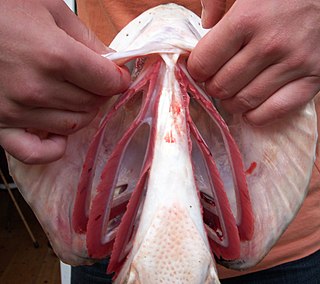
Branchial arches or gill arches are a series of paired bony/cartilaginous "loops" behind the throat of fish, which support the fish gills. As chordates, all vertebrate embryos develop pharyngeal arches, though the eventual fate of these arches varies between taxa. In all jawed fish (gnathostomes), the first arch pair develops into the jaw, the second gill arches develop into the hyomandibular complex, and the remaining posterior arches support the gills. In tetrapods, a mostly terrestrial clade evolved from lobe-finned fish, many pharyngeal arch elements are lost, including the gill arches. In amphibians and reptiles, only the oral jaws and a hyoid apparatus remains, and in mammals and birds the hyoid is simplified further to support the tongue and floor of the mouth. In mammals, the first and second pharyngeal arches also give rise to the auditory ossicles.

Eodicynodon is an extinct genus of dicynodont therapsids, a highly diverse group of herbivorous synapsids that were widespread during the middle-late Permian and early Triassic. As its name suggests, Eodicynodon is the oldest and most primitive dicynodont yet identified, ranging from the middle to late Permian and possessing a mix of ancestral anomodont/therapsid features and derived dicynodont synapomorphies.
Cranial kinesis is the term for significant movement of skull bones relative to each other in addition to movement at the joint between the upper and lower jaws. It is usually taken to mean relative movement between the upper jaw and the braincase.
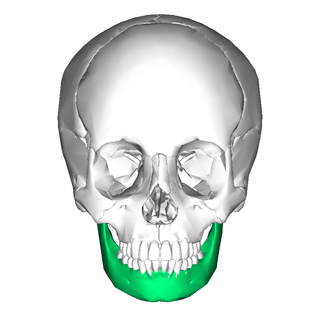
In jawed vertebrates, the mandible, lower jaw, or jawbone is a bone that makes up the lower – and typically more mobile – component of the mouth.

Bicentenaria is an extinct genus of carnivorous coelurosaurian theropods which lived during the early Late Cretaceous (Cenomanian) Candeleros Formation of Argentina. It contains the type species, B. argentina.

Most bony fishes have two sets of jaws made mainly of bone. The primary oral jaws open and close the mouth, and a second set of pharyngeal jaws are positioned at the back of the throat. The oral jaws are used to capture and manipulate prey by biting and crushing. The pharyngeal jaws, so-called because they are positioned within the pharynx, are used to further process the food and move it from the mouth to the stomach.
This Glossary explains technical terms commonly employed in the description of dinosaur body fossils. Besides dinosaur-specific terms, it covers terms with wider usage, when these are of central importance in the study of dinosaurs or when their discussion in the context of dinosaurs is beneficial. The glossary does not cover ichnological and bone histological terms, nor does it cover measurements.

Posselt's envelope of motion or Posselt's envelope of movement refers to the range of motion of the lower jaw bone, or mandible.




















